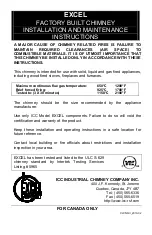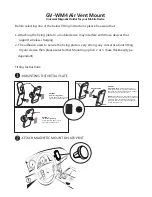
3. Make sure that the amplitude, frequency and shape are all present, repeatable, and consistent. Amplitude should
be close to 5 V.
Frequency should vary with vacuum. Shape should stay constant (square wave).
4. Make sure the sensor produces the correc t f requency for a given amount of vacuum, according to t he
specification chart for the vehicle you are working on.
5. Use the Glitch Snare mode to detect dropouts or unstable output frequency.
• Reference Waveform
VEHICLE INFORMATIONS
YEAR
: 1993
MAKE
: Ford
MODEL
: F150 4WD Pickup
ENGINE
: 5.0 L
FUELSYS : Multiport Fuel Injection
PCM_PIN : 45 LtGrn Blk wire
STATUS
: KOEO (Key On Engine Off)
RPM
: 0
ENG_TMP : Operating Temperature
VACUUM : 0 In. Hg
MILEAGE : 66748
• Troubleshooting Tips
A bad digital MAP sensor can produce incorrect frequencies, runted (shortened) pulses, unwanted spikes and
rounded off corners that could all have the effect of garbling “electronic communication”, thus causing a driveability
or emissions problem.
Analog Mass Air Flow (MAF) Sensor
• Theory of Operation
There are two main varieties of analog MAF sensors; Hot Wire type and Vane type. Hot wire type MAF sensors use
heated-metal-foil sensing element to measure air flow entering the intake manifold. The sensing element is heated to
about 170 °F (77 °C), above the temperature of incoming air. As air flows over the sensing element, it cools the
element, causing resistance to drop. This causes a corresponding increase in current flow, which causes supply
voltage to decrease. This signal is seen by the PCM as a change in voltage drop (high air flow = high voltage) and is
used as an indication of air flow. The PCM uses this signal to calculate engine load, to determine the right amount of
fuel to be mixed with the air, and ignition timing, EGR control, idle control, transmission shift points, etc.
6-25
FREQ = 159 Hz
MAX = 5.06 V
MIN = -133 mV
Ford digital MAP sensor
Key On Engine Off (KOEO)
Frequency decreases as vacuum increases. Look for pulses that are a full 5 V in
amplitude. Voltage transitions should be straight and vertical. Voltage drop to ground
should not exceed 400 mV. If the voltage drop is greater than 400 mV, look for a bad
ground at the sensor or the PCM.
IMPORTANT: There are a few MAP sensors designed to do the opposite (high vacuum = high voltage).
Some Chrysler MAP sensors just stay at a f ixed voltage when they fail, regardless of changes in
vacuum level. Generally 4 cylinder engines make nosier waveforms because their vacuum fluctuates
more between intake strokes.
• Troubleshooting Tips
Digital Manifold Absolute Pressure (MAP) Sensor
• Theory of Operation
Ford’s digital MAP sensor is found on many Ford and Lincoln Mercury vehicles from the early 1980’s to well into the
1990’s. This sensor produces a f requency modulated square wave whose f requency varies with the amount of
intake vacuum sensed. It generates about 160 Hz with no vacuum applied, and it generates about 105 Hz when it is
sensing around 19 In.Hg at idle. Check the manufacturer’s specs for the year, make and model for exact vacuum
versus frequency reference numbers. This is a three wire sensor, supplied with 5 V V Ref power, a ground circuit,
and the digital signal output pulses based on the amount of vacuum it senses.
• Symptoms [OBD II DTC’s: P0105 ~ P0109]
Low power, stall, hesitation, excessive fuel consumption, emissions failure
• Test Procedure
1. Connect the CH A lead to the sensor output or HI and its ground lead to the sensor output LO or GND.
2. With the Key On, Engine Off (KOEO), apply different amounts of vacuum to the sensor using a handheld vacuum
pump.
6-24
Check the manufacturer’s specifications for exact voltage range versus vacuum levels,
and compare them to the readings on the display. Generally the sensor voltage should
range about 1.25 V at idle t o just under 5 V at WOT and close to 0 V on full
deceleration. High vacuum (around 24 I n. Hg on full decel) produces low volt age
(close to 0 V), and low vacuum (around 3 In. Hg at full load) produces high voltage
(close to 5 V).
HIGH ENGINE LOAD
LOW ENGINE LOAD
A high voltage level indicates
high intake manifold pressure
(low vacuum).
As the throttle plate opens,
manifold pressure rises
(manifold vacuum lowers).
A low voltage level indicates
low intake manifold pressure
(high vacuum).
















































